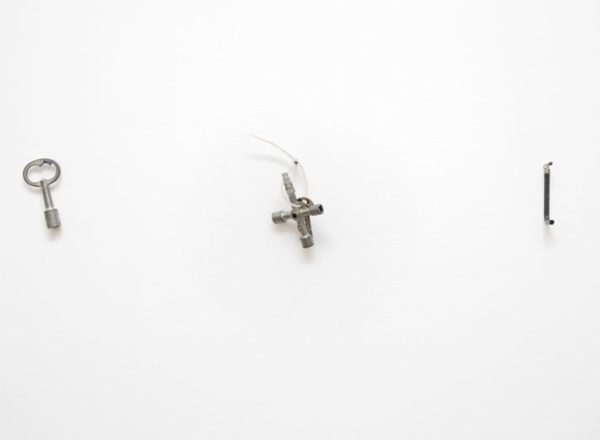


David Horvitz
Born in 1981, David Horvitz lives and works in Los Angeles (United States).
Graduated in 2010 from the Milton Avery School of the Arts at Bard College, New York.
Represented by the ChertLüdde Gallery (Berlin).
 Eridanus (Paris), 2017
Eridanus (Paris), 2017
Digital slide show of 60 images, set of 60 photographs and map
Variable dimensions/photographs: 10 x 15 cm each, map: 49 x 63.5 cm
Work acquired in 2017
photo Aurélien Mole
 Le Gamin Ennemi des Lumières, 2017
Le Gamin Ennemi des Lumières, 2017
8 keys of different shapes, map
Keys: variable dimensions, map: 45.5 x 98 cm (unfolded), 12 x 10 cm (folded)
Work acquired in 2017
photo Aurélien Mole
For his solo exhibition at the Galerie Allen in Paris in March 2017, David Horvitz took his inspiration from the accounts of Parisians compiled at the time when public street lighting was introduced. Many of them lamented the fact that the stars were no longer visible at night. The artist makes use of the shape of the Eridanus Constellation, visible in the southern hemisphere and described as a long, sinuous line, similar to a river. Moreover, in Greek mythology, the name ‘Eridanos’ means river. Projecting the shape of the constellation onto a map of Paris, the artist spent an entire night wandering the city, following the path of the stars to guide his steps, in a kind of psycho-geographical experience1. On his journey, he found 30 street lights, corresponding to the positions occupied by the stars in the sky. He then proceeded to put out these street lights, creating in his own words: ‘a constellation, not of light, but of darkness’2, returning ‘the street to the night’3, concluding that ‘maybe, just maybe, some stars returned to the sky’4. The works in the collection constitute a set of clues reproducing this poetic experience: the map of Paris, ‘perforated’ by the contours of the constellation situating the street lights, as well as a slide show of 60 photographs, showing each lamppost on and then, off. It also includes a mural installation displaying the keys used to access the street lights and to switch them off.
David Horvitz uses mail art, artist’s books, and photographs to explore the phenomenon of networks, particularly virtual ones. His interventions, often simple and occurring on a daily basis, highlight systems of digital communication and the dissemination of information. For one of his projects, he photographed himself with his head in his hands, in front of a stormy sea, producing a generic image on the theme of depression. He then published his image as an illustration for the Wikipedia page dealing with the topic of ‘mood disorders’. The image then spread on the Internet, accompanying multiple articles on the subject (Mood Disorder, 2012). In this project, as well as others, David Horvitz refers to Dutch artist Bas Jan Ader. His work also contains some similarities with the Fluxus movement, as well as with key figures of Conceptual art, such On Kawara and his exploration of the concept of time.
Psycho-geography is a term coined by writer Guy Debord and the Situationists, which establishes a relationship between the psyche and a physical place. Wandering, particularly in urban spaces, allows one to experience such a sentiment.